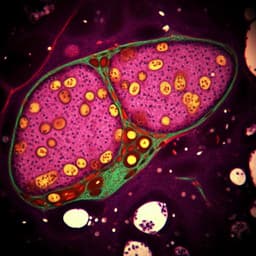
Medicine and Health
Omega-3 PUFAs prevent bone impairment and bone marrow adiposity in mouse model of obesity
A. Benova, M. Ferencakova, et al.
Discover how omega-3 polyunsaturated fatty acids can transform bone and fat metabolism! This groundbreaking research by Andrea Benova and colleagues reveals that omega-3 PUFA supplementation not only improves bone strength but also reduces bone marrow adipose tissue in obese mice. A potential game changer for metabolic bone diseases!
~3 min • Beginner • English
Introduction
The study addresses how omega-3 polyunsaturated fatty acids (PUFAs) influence bone homeostasis under obesogenic conditions, focusing on bone marrow adipose tissue (BMAT) and bone marrow stromal cell (BMSC) metabolism. Obesity, driven by excess caloric intake and diets rich in saturated and trans-unsaturated fatty acids, increases fracture risk and impairs bone quality, partly via increased BMSC adipogenesis and a senescent marrow microenvironment. Omega-3 PUFAs (EPA and DHA) have documented benefits on lipid metabolism, inflammation, and bone health, but their in vivo effects on BMAT and marrow cell populations during early obesity have not been fully elucidated. The study aims to determine whether supplementation of a high-fat diet (HFD) with omega-3 PUFAs can prevent adverse changes in bone microstructure, BMAT, and the molecular and functional characteristics of BMSCs and osteoclasts (OCs) in young male C57BL/6N mice.
Literature Review
Prior animal and human studies indicate omega-3 PUFAs can mitigate bone loss and improve bone quality across conditions including osteoporosis, obesity, and aging. Long-term omega-3 supplementation has reduced osteoclastogenesis and BMAT expansion in aging/OVX models. One HFD study in C57BL/6 mice reported improved bone parameters with omega-3 supplementation over six months. In vitro, omega-3 PUFAs modulate BMSC membrane composition to favor osteogenesis, and can restore osteoblastic differentiation while inhibiting osteoclast differentiation in cell models. Nevertheless, effects on BMAT and primary marrow-derived cells in vivo at early stages of diet-induced obesity remained underexplored. The discussion situates current findings alongside reports showing variable outcomes dependent on age, sex, disease model, duration, and assessment methods, emphasizing novel BMAT imaging (CECT with Hexabrix) and cellular phenotyping advances made here.
Methodology
Animal model: Male C57BL/6N mice (10 weeks old at purchase) were acclimated and then randomized at 12 weeks to 8-week diets: (a) normal chow (ND, 3.4% lipid), (b) high-fat diet (HFD, ~35% lipid from corn oil), or (c) HFD supplemented with omega-3 concentrate (HFD+F; EPAX 1050 TG providing 46% DHA, 14% EPA; replacing 15% dietary lipids to achieve 30 mg/g diet EPA+DHA; ~0.168 g EPAX/mouse over study). Body weight and food intake were monitored weekly. Glucose tolerance tests and fasting insulin were assessed with standard protocols. All procedures followed institutional approvals.
Bone assessments: Ex vivo micro-computed tomography (µCT; SkyScan 1272, 3 µm voxel) analyzed trabecular and cortical microarchitecture in proximal tibia and L5 vertebrae with standardized reconstruction and region-of-interest definitions. Bone strength was measured by three-point bending of femora (span 7 mm, rate 0.1 mm/s) to determine ultimate load, stiffness, and work-to-failure.
BMAT imaging: Contrast-enhanced X-ray microfocus CT (CECT) used Hexabrix staining of formalin-fixed proximal tibias (≥3 days) and high-resolution scanning (Phoenix NanoTom M). Image processing segmented cortical/trabecular bone and BM, then adipocytes using global thresholds and Avizo-based watershed. Quantified BM adipocyte number, volume, diameter, area density.
Biochemistry: Serum bone turnover markers measured by EIA (TRAP for resorption, P1NP for formation) and expressed as P1NP/TRAP ratio.
Cell isolations and culture: Primary BMSCs were isolated from limb bones after collagenase digestion and lineage depletion (CD45/CD31/Ter119 negative selection) and cultured in alpha-MEM-based media. Hematopoietic stem cells (HSCs; positive fraction) were collected for RNA/protein and culture.
BMSC differentiation: Osteoblast (OB) differentiation induced with β-glycerophosphate, dexamethasone, and vitamin C; endpoints included Alizarin Red (day 11), ALP activity (day 7), and osteogenic gene expression (Alpl, Oc, Col1a1, Bmp2, Ctnnb1). Adipocyte (AD) differentiation used DMEM-based hormonal cocktail; Oil Red O staining and adipogenic/inflammatory/oxidative stress/senescence gene expression (Pparγ2, Cebpa, Adipoq, Cd36, Fsp27, Vcam, Sod2, Hmox1, p53, Tnfa) were assessed.
Osteoclast analyses: Primary bone marrow (BM) cells were differentiated with M-CSF and RANKL for 5 days. TRAP staining counted total and large OCs (>500 µm, >30 nuclei). TRACP activity was measured and normalized to OC number. In vitro short-term treatments with 100 µM EPA, DHA, or their mix assessed OC differentiation and OC gene expression (Trap, Ctsk).
HSC signaling: HSCs were stimulated with insulin (100 nM, 15 min) or LPS (1 µg/mL, 15 min). Western blots quantified p-AKT (Ser473, Thr308) and p-NFκB p65 relative to total proteins. HSC bone resorption-related genes (Trap, Rankl, Opg, Ctsk) were measured by qRT-PCR.
Bioenergetics and senescence: Seahorse XFe24 measured OCR and ECAR in undifferentiated BMSCs under basal and pharmacologic conditions (glucose, oligomycin, FCCP, rotenone+antimycin A+2DG). Senescence-associated β-galactosidase (SA-β-gal) activity and reactive oxygen species (ROS) production were quantified in BMSCs. SASP gene expression was measured in BMSCs (and HSCs in supplement) after oxidative challenge.
Lipidomics/metabolomics: Untargeted/targeted LC-MS profiling (LIMEX workflow) of plasma, BM, and bone powder (BP) quantified 905 metabolites (polar and lipids) across four LC-MS platforms (RPLC-MS positive/negative for lipids; HILIC-MS positive and RPLC-MS negative for polar metabolites). Data processing used MS-DIAL with QC-based LOESS normalization and FDR-controlled statistics. PLS-DA explored group separations.
Statistics: Data are means ± SEM. Group comparisons used unpaired t-tests or one-way ANOVA with Tukey or Bonferroni post hoc tests. P<0.05 considered significant.
Key Findings
- Bone microarchitecture and strength: HFD increased L5 cortical porosity and decreased cortical thickness versus ND, while omega-3 supplementation (HFD+F) improved L5 cortical porosity (HFD vs HFD+F, p=0.0101), cortical thickness (p=0.0384), cortical BV/TV (p=0.0465), and cortical area fraction B.Ar/T.Ar (p=0.0465) beyond ND levels. In proximal tibia, HFD+F increased trabecular BV/TV and trabecular number versus HFD. Three-point bending showed higher ultimate femoral strength in HFD+F versus HFD and ND. Circulating P1NP/TRAP ratio increased in HFD+F vs ND (p=0.0038), indicating higher net bone formation.
- BMAT: CECT of Hexabrix-stained tibias showed HFD increased BM adipocyte number, volume, and diameter, all prevented by omega-3 supplementation (BMAd number HFD vs HFD+F, p=0.0005). Histomorphometry corroborated reduced BMAT area and adipocyte density in HFD+F to ND-like levels.
- Lipidomics/metabolomics: In plasma, 24/32 lipid classes were significantly decreased in HFD+F versus HFD, notably triglycerides, diacylglycerols, cholesterol, ceramides, and phosphatidylcholines. In BM, LPG, NAE, and EtherPI were altered; in BP, FAHFA, EtherPI, EtherTG, and CE were altered. DHA (22:6n-3) and EPA (20:5n-3) were enriched in plasma and BM of HFD+F versus HFD, aligning with improved BM microenvironment.
- BMSC phenotype: HFD+F increased CFU-f numbers versus HFD, reduced adipogenic differentiation (less Oil Red O staining; downregulation of Pparγ2, Cebpa, Adipoq, Cd36, Fsp27, Vcam), reduced oxidative stress/inflammation markers (Hmox1, Tnfa) and senescence marker p53 versus HFD/ND. Osteogenic differentiation was improved by HFD+F (increased Alizarin Red staining, ALP activity, and osteogenic genes Alpl, Oc, Col1a1, Bmp2, Ctnnb1) compared to HFD.
- Osteoclasts: In primary BM-derived cultures, total TRAP+ OCs were higher in HFD vs ND (p=0.0258). Omega-3 supplementation reduced OC formation and the proportion of large OCs (ND vs HFD, p=0.038; HFD vs HFD+F, p=0.048). TRACP activity and OC gene expression (Trap, Ctsk) were unchanged among diet groups, with a trend toward lower inflammatory Il1b in HFD+F.
- HSC signaling: Insulin-stimulated pAKT signaling was not impaired in HFD vs ND; however, HFD+F reduced insulin responsiveness vs HFD, particularly pAKT Thr308 (p=0.0341). LPS-stimulated NFκB p65 phosphorylation increased in HFD and was reduced by HFD+F (HFD vs HFD+F, p=0.0125). Trends suggested lower Rankl/Opg expression in HFD+F HSCs.
- Bioenergetics and senescence in BMSCs: HFD increased basal and maximal OCR; HFD+F reduced OCR and glycolytic capacity (ECAR), yielding a quiescent metabolic phenotype. HFD+F decreased SA-β-gal activity and ROS production versus HFD (p=0.0185 and p=0.0223), accompanied by lower SASP gene expression (Fas, Faslg, Il1β, Vegfa, Vcam, Il10, Il1rn).
Discussion
The study demonstrates that supplementing an obesogenic diet with omega-3 PUFAs mitigates HFD-induced cortical deterioration in vertebrae, improves trabecular architecture in tibia, and enhances bone strength. Omega-3 supplementation reduced BMAT expansion and normalized adipocyte size/number to ND-like levels, indicating a healthier marrow milieu. Concomitantly, BMSCs from omega-3–supplemented mice shifted away from adipogenesis toward osteogenesis, exhibited reduced oxidative stress and senescence, and displayed a quiescent bioenergetic state, collectively favoring bone formation. Osteoclastogenesis was attenuated (fewer and smaller OCs), and HSCs exhibited dampened inflammatory NFκB signaling, suggesting broader immune-marrow benefits. Lipidomic findings of lower circulating atherogenic lipid classes and elevated EPA/DHA in BM support systemic and local mechanisms underpinning bone benefits. These results address the hypothesis that omega-3 PUFAs can counter early obesogenic insults to bone and marrow, extending prior reports by integrating advanced BMAT imaging (Hexabrix-based CECT), multi-omics, and primary cell functional assays. The data underscore the marrow microenvironment as a target for dietary interventions to improve skeletal health in metabolic disease.
Conclusion
Omega-3 PUFA supplementation during early diet-induced obesity improves bone microarchitecture and mechanical strength, reduces BMAT, promotes osteogenic and suppresses adipogenic differentiation of BMSCs, decreases osteoclast formation, and dampens HSC inflammatory signaling. Multi-omics analyses corroborate systemic lipid improvements and increased EPA/DHA bioavailability within marrow. These findings highlight omega-3 PUFAs as a potential non-pharmacological strategy to prevent metabolic bone disease. Future studies should explore longer interventions, sex-specific responses (including females), detailed osteoclast functional heterogeneity (e.g., single-cell RNA-seq and osteomorph dynamics), and the comparative roles of different PUFA classes (omega-3/6/9) and dietary compositions.
Limitations
- Duration and model: Only 8 weeks of dietary intervention in young male C57BL/6N mice; HFD alone produced relatively modest bone and BMSC senescence changes versus ND, potentially limiting effect size contrasts.
- Sex not evaluated: Female mice were not studied, limiting generalizability and implications for conditions like postmenopausal osteoporosis.
- Functional osteoclast activity: While OC numbers and size distribution changed, TRACP activity and OC gene expression did not differ significantly; deeper functional profiling (e.g., single-cell analyses) was not performed.
- Early timepoint focus: Findings pertain to early obesity; longer-term outcomes remain to be determined.
Related Publications
Explore these studies to deepen your understanding of the subject.







